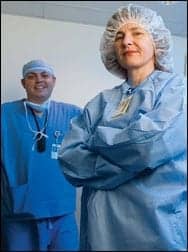Fujifilm Sonosite Inc. has added to its point-of-care ultrasound (POCUS) portfolio with the launch of the Sonosite LX system, which features a monitor that extends, rotates, and tilts to enable real-time provider collaboration. The clinical display features touchscreen controls to enable an optimized heads-up workflow, allowing clinicians to keep their eyes on the image while making adjustments.
Designed to be used with the Sonosite LX and Sonosite PX, the company has also launched a new T8-3 transesophageal transducer and Cardiac Resuscitation exam type, to assist clinicians in using transesophageal ultrasound (TEU) at the point of care.
“Sonosite LX was inspired by and designed with clinician partners, focusing on the evolving ways ultrasound can support the quadruple aim at the point of care, wherever that may be,” says Rich Fabian, president and COO of Fujifilm Sonosite. “This launch reflects an ongoing commitment to delivering leading-edge technology for clinicians and their patients, technology that’s backed up by a world-class ecosystem of services, support, and education.”
Sonosite LX POCUS
Sonosite LX has an adaptable, 21.3-inch clinical display that extends, rotates, and tilts to accommodate the varied clinical environments at the bedside. The system’s small footprint and adjustable display foster collaboration, allowing for real-time image and information-sharing with the patient, other clinicians, residents, and other hospital staff.
The system was engineered to include primary and secondary study controls on the clinical touchscreen display—including quick access to the most-used optimizations such as depth, gain, and measurements—to deliver an optimized heads-up workflow for clinicians. The Sonosite LX is compatible with the redesigned line of transducers launched with Sonosite PX that have dedicated exam types for study-specific imaging and workflow optimization.
Fujifilm Sonosite T8-3 TEU
Responding to expressed customer need, Sonosite developed the T8-3 transducer, enabling clinicians to provide TEU at the point of care by:
- Enabling repeatable cardiac imaging regardless of patient condition or body habitus
- Providing a lightweight handle and flexible shaft for easy manipulation and a small tip for ease of insertion
- Enabling low power consumption to maintain temperature while monitoring over time
Abbott Northwestern in Minneapolis recently purchased six T8-3 transducers to aid in cardiac resuscitation throughout their hospital.
“We want to provide our physicians with the tool that ensures real-time heart and lung visualization during patient resuscitation when transcutaneous imaging windows are inadequate and a patient, regardless of location in the hospital, might benefit,” says David Tierney, MD, program director, Abbott Northwestern Hospital Internal Medicine Residency Program, part of Allina Health. “This information helps our resuscitation team make rapid and potentially life-saving decisions at the bedside and further improve shock and arrest outcomes for our patients.”





